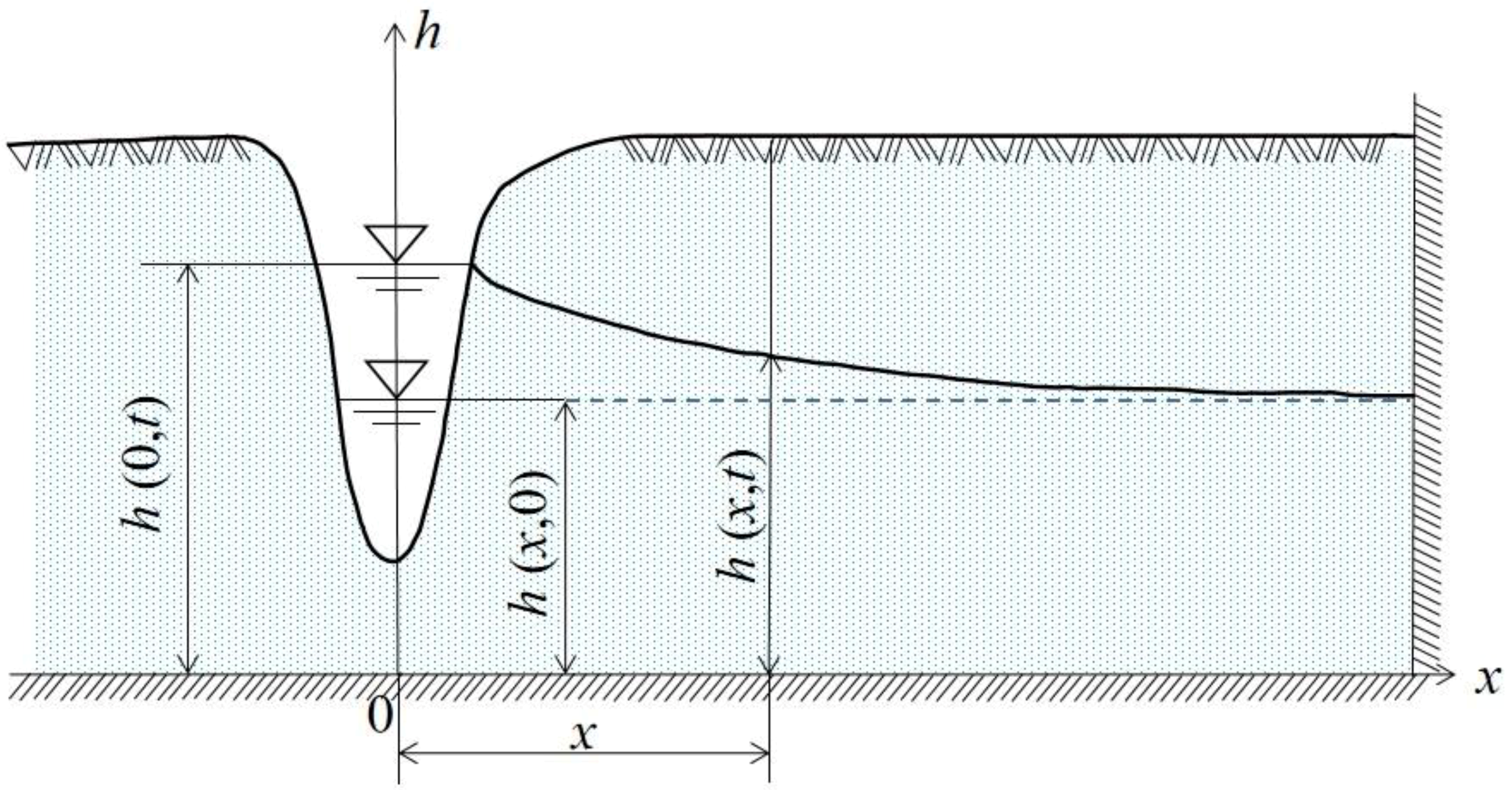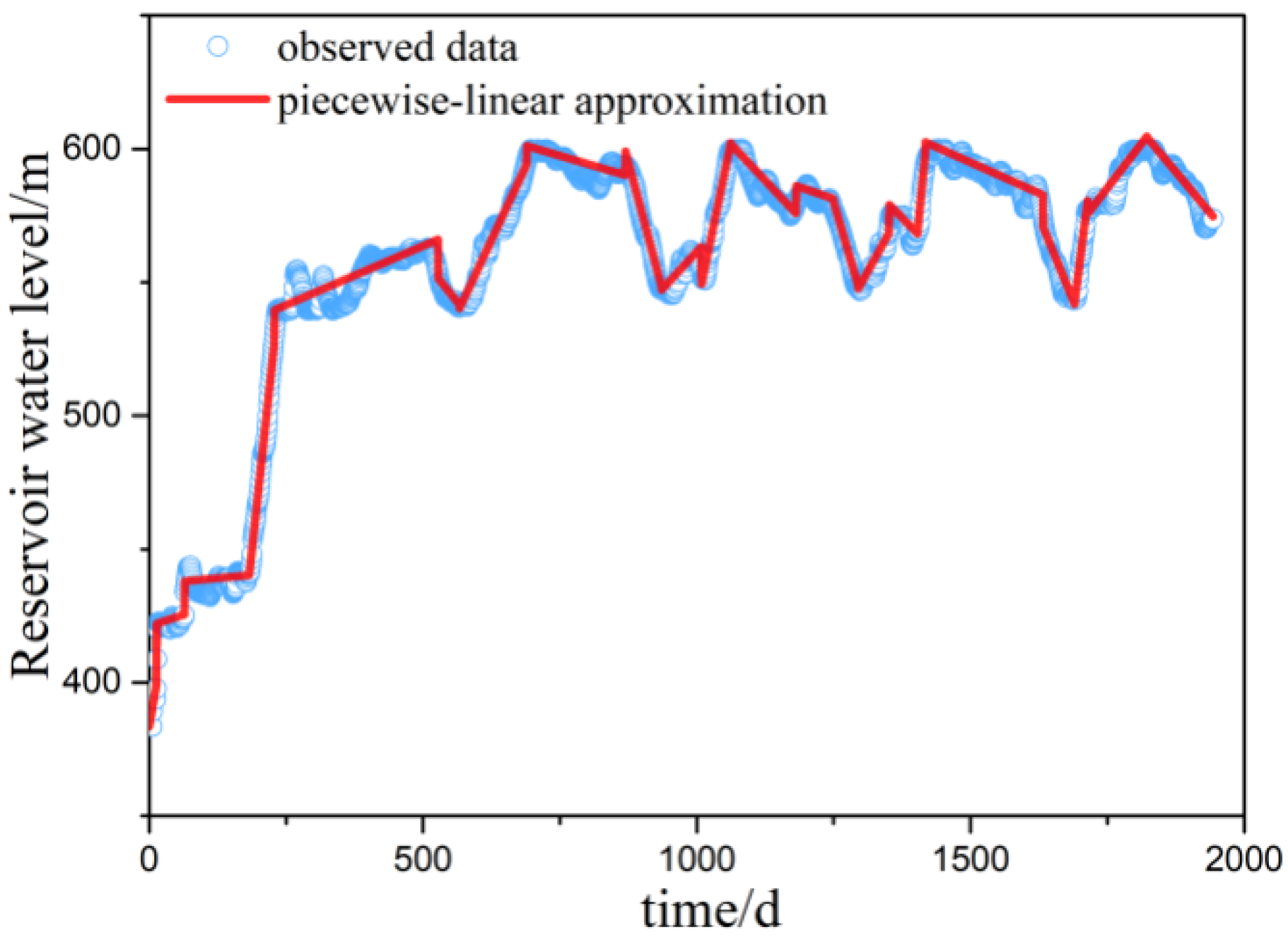Analytical Solutions for Unsteady Groundwater Flow in an Unconfined Aquifer under Complex Boundary Conditions
Abstract
:1. Introduction
2. Theory and Methodology
2.1. Linearization and Solution of the Groundwater Flow Model near the Riverbank
2.2. Simple Representation of the Piecewise-Linear Approximation for River Level Boundary
2.3. Simple Representation of the Piecewise-Constant Step Approximation for River Level Boundary
3. Field Application
3.1. Background
3.2. Representation of River Level
3.3. Model Calculation
3.4. Prediction of Groundwater Level Fluctuation Caused by Reservoir Water Level Variation
4. Results and Discussions
4.1. Effect of Boundary Water Level Approximation
4.2. Effect of Models Accuracy
4.3. Effect of Damping in the Unconfined Aquifer
5. Conclusions
Author Contributions
Funding
Conflicts of Interest
References
- Lischeid, G. Drivers of water level fluctuations and hydrological exchange between groundwater and surface water at the lowland River Spree (Germany): Field study and statistical. Hydrol. Processes 2009, 23, 2117–2128. [Google Scholar]
- Mclachlan, P.J.; Chambers, J.E.; Uhlemann, S.S.; Binley, A. Geophysical characterisation of the groundwater-surface water interface. Adv. Water Resour. 2017, 109, 302–319. [Google Scholar] [CrossRef] [Green Version]
- Chen, J.W.; Hsieh, H.H.; Yeh, H.F.; Lee, C.H. The effect of the variation of river water levels on the estimation of groundwater recharge in the Hsinhuwei River, Taiwan. Environ. Earth Sci. 2010, 59, 1297–1307. [Google Scholar] [CrossRef]
- Zhou, Z.; Wang, J. Groundwater Dynamics; Science Press: Beijing, China, 2013. [Google Scholar]
- Rushton, K. Representation in regional models of saturated river-aquifer interaction for gaining/losing rivers. J. Hydrol. 2007, 334, 262–281. [Google Scholar] [CrossRef]
- Goerlitz, D.F.; Troutman, D.E.; Godsy, E.M.; Franks, B.J. Migration of wood-preserving chemicals in contaminated groundwater in a sand aquifer at Pensacoia, Florida. Environ. Sci. Technol. 1985, 19, 955–961. [Google Scholar] [CrossRef]
- Zhao, M.L. Finite element numerical simulation of two-dimensional ground water solute migration question. Adv. Mater. Res. 2011, 301–303, 352–356. [Google Scholar] [CrossRef]
- Luo, Z.; Yang, L.; Li, Z.; Wang, J. Three-dimensional numerical simulation for immersion prediction of left bank of Songyuan reservoir project. Trans. Chin. Soc. Agric. Eng. 2012, 28, 129–134. [Google Scholar]
- Celia, M.A.; Bouloutas, E.T.; Zarba, R.L. A general mass-conservative numerical solution for the unsaturated flow equation. Water Resour. Res. 1990, 26, 1483–1496. [Google Scholar] [CrossRef]
- Li, M.; Zhou, Z.; Yang, Y.; Xin, Y.; Liu, Y.; Guo, S.; Zhu, Y.; Jin, D. Immersion assessment and control of the right bank of Xingan navigation and power junction. J. Hohai Univ. Sci. 2018, 46, 203–210. [Google Scholar]
- Pinder, G.F.; Sauer, S.P. Numerical simulation of flood wave modification due to bank storage effects. Water Resour. Res. 1971, 7, 63–70. [Google Scholar] [CrossRef]
- Yuan, F.; Lu, Z. Analytical solutions for vertical flow in unsaturated, rooted soils with variable surface fluxes. Vadose Zone J. 2005, 4, 1210–1218. [Google Scholar] [CrossRef]
- Ferris, J.G.; Knowles, D.B.; Brown, R.H.; Stallman, R.W. Theory of Aquifer Tests; US Geological Survey: Denver, CO, USA, 1962.
- Mahdavi, A. Transient-state analytical solution for groundwater recharge in anisotropic sloping aquifer. Water Resour. Manag. 2015, 29, 3735–3748. [Google Scholar] [CrossRef]
- Su, N. The fractional Boussinesq equation of groundwater flow and its applications. J. Hydrol. 2017, 547, 403–412. [Google Scholar] [CrossRef] [Green Version]
- Wu, D.; Tao, Y.; Lin, F. Application of unsteady phreatic flow model and its solution under the boundary control of complicated function. J. Hydraul. Eng. 2018, 6, 725–731. [Google Scholar]
- Zhang, W. Calculation of Unsteady Groundwater Flow and Evaluation of Groundwater Resources; Science Press: Beijing, China, 1983. [Google Scholar]
- Bansal, R.K. Approximation of surface–groundwater interaction mediated by vertical streambank in sloping terrains. J. Ocean Eng. Sci. 2017, 2, 18–27. [Google Scholar] [CrossRef] [Green Version]
- Mishra, P.K.; Vessilinov, V.; Gupta, H. On simulation and analysis of variable-rate pumping tests. Groundwater 2013, 51, 469–473. [Google Scholar] [CrossRef]
- Stewart, G.; Watt, H.U.; Wittmann, M.J.; Meunier, D. After flow measurement and deconvolution in well test analysis. In Proceedings of the SPE Annual Technical Conference and Exhibition, San Francisco, CA, USA, 5–8 October 1983. [Google Scholar]
- Zhuang, C.; Zhou, Z.; Zhan, H.; Wang, G. A new type curve method for estimating aquitard hydraulic parameters in a multi-layered aquifer system. J. Hydrol. 2015, 527, 212–220. [Google Scholar] [CrossRef]
- Lee, J.; Wilson, D. Polyhedral methods for piecewise-linear functions I: The lambda method. Discret. Appl. Math. 2001, 108, 269–285. [Google Scholar] [CrossRef] [Green Version]
- Sontag, E.D. Nonlinear Regulation: The Piecewise Linear Approach. IEEE Trans. Automat. Control 1981, 26, 346–358. [Google Scholar] [CrossRef]
- Zhou, Z.; Li, M.; Zhuang, C.; Guo, Q. Impact factors and forming conditions of valley deformation of Xiluodu Hydropower Station. J. Hohai Univ. Sci. 2018, 46, 31–39. [Google Scholar]
- Becker, B.; Jansen, M.; Sinaba, B.; Schüttrumpf, H. On the modeling of bank storage in a groundwater model: The April, 1983, flood event in the Neuwieder Becken (Middle Rhine). J. Water 2015, 7, 1173–1201. [Google Scholar] [CrossRef] [Green Version]






| Linear Approximation | Step Approximation | ||||
|---|---|---|---|---|---|
| RMSE | RE | RMSE | RE | ||
| i = 7 | X35 | 1.74 | 0.0033 | 2.33 | 0.0046 |
| X50 | 2.35 | 0.0047 | 2.63 | 0.0053 | |
| i = 17 | X35 | 1.50 | 0.0028 | 1.81 | 0.0036 |
| X50 | 1.82 | 0.0036 | 2.52 | 0.0049 | |
© 2019 by the authors. Licensee MDPI, Basel, Switzerland. This article is an open access article distributed under the terms and conditions of the Creative Commons Attribution (CC BY) license (http://creativecommons.org/licenses/by/4.0/).
Share and Cite
Xin, Y.; Zhou, Z.; Li, M.; Zhuang, C. Analytical Solutions for Unsteady Groundwater Flow in an Unconfined Aquifer under Complex Boundary Conditions. Water 2020, 12, 75. https://doi.org/10.3390/w12010075
Xin Y, Zhou Z, Li M, Zhuang C. Analytical Solutions for Unsteady Groundwater Flow in an Unconfined Aquifer under Complex Boundary Conditions. Water. 2020; 12(1):75. https://doi.org/10.3390/w12010075
Chicago/Turabian StyleXin, Yawen, Zhifang Zhou, Mingwei Li, and Chao Zhuang. 2020. "Analytical Solutions for Unsteady Groundwater Flow in an Unconfined Aquifer under Complex Boundary Conditions" Water 12, no. 1: 75. https://doi.org/10.3390/w12010075
APA StyleXin, Y., Zhou, Z., Li, M., & Zhuang, C. (2020). Analytical Solutions for Unsteady Groundwater Flow in an Unconfined Aquifer under Complex Boundary Conditions. Water, 12(1), 75. https://doi.org/10.3390/w12010075





